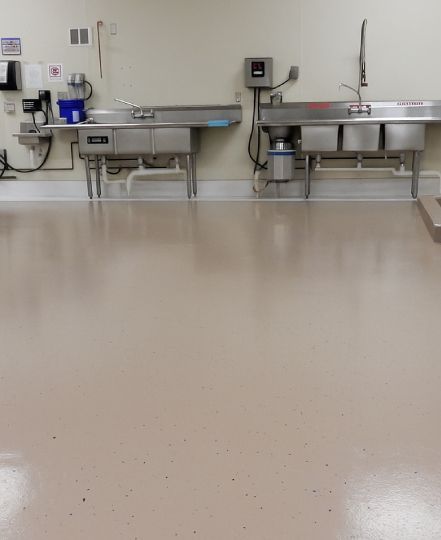What is Food-Grade Epoxy Flooring and Why is it Important?
Introduction: The Critical Role of Sanitary Flooring in Food Environments
In food production, sanitation is more than a priority — it’s the bedrock of safe, compliant, and efficient operations. From busy commercial kitchens to dairy and meat processing plants, every square foot of flooring must support cleanliness, reduce contamination, and meet strict USDA, FDA, and HACCP standards.
In Manchester, New Hampshire, the Health Department conducts risk‑based inspections of over 750 licensed food service venues each year, making seamless, food‑safe flooring a priority for any operator looking to maintain top inspection scores and prevent critical violations.
Food-grade epoxy flooring is the gold standard for these demanding environments. Engineered to deliver a seamless, non-porous, chemical-resistant surface, this type of industrial flooring is designed to stand up to extreme wear while supporting rigorous hygiene protocols.
What is Food-Grade Epoxy Flooring?
Food-grade epoxy flooring is a specialized resin-based coating system formulated for food processing and handling areas. It combines high-solids epoxy resins with hardeners and sometimes aggregates to form a durable, impermeable surface.
Key Characteristics of Food-Safe Epoxy Flooring
- Seamless and non-porous – eliminates grout lines and cracks that harbor bacteria
- Chemical-resistant – withstands cleaning agents, acids, alkalis, and food oils
- Slip-resistant – optional textured or broadcast surfaces improve safety
- Moisture-resistant – ideal for wet zones, washdown areas, and steam cleaning
- Thermal shock tolerant – resists damage from temperature fluctuations and hot water discharges
Why is Food-Grade Epoxy Flooring So Important?
The food and beverage industry operates under some of the strictest health and safety regulations. Your flooring must do more than support foot traffic—it must actively protect your product, your workers, and your reputation.
Regulatory Compliance
Food-grade epoxy coatings are designed to meet or exceed standards set by:
- FDA (Food and Drug Administration)
- USDA (United States Department of Agriculture)
- HACCP (Hazard Analysis and Critical Control Points)
- NSF/ANSI Standard 51 for food equipment surfaces
In Manchester, New Hampshire, code § 117.27 requires every food service establishment to be inspected at least twice a year, making seamless and impermeable flooring an essential element for passing routine health and safety evaluations.
Failure to meet these standards can lead to:
- Fines and shutdowns
- Product contamination
- Damage to brand trust
- Legal liabilities
Health and Sanitation
Without the right flooring, bacteria and pathogens can thrive in cracks, seams, or porous materials. Epoxy provides a monolithic surface that resists bacterial growth, mold, and mildew—making it ideal for:
- Food prep areas
- Walk-in coolers and freezers
- Beverage bottling lines
- Seafood processing stations
With New Hampshire’s Food Protection program overseeing roughly 4,600 licensed facilities, many Manchester businesses are choosing epoxy flooring to stay compliant. Its seamless, durable surface helps reduce the risk of costly fines, penalties, and downtime caused by inspection failures.
Industries That Require Food-Grade Epoxy Flooring
Food-safe epoxy isn’t just for commercial kitchens. It's a critical flooring choice for industries where safety, durability, and sanitation are top priorities:
Common Applications
- Meat and poultry processing plants
- Bakeries and confectioneries
- Beverage and brewery facilities
- Dairies and cheese plants
- Frozen food packaging centers
- Canning and bottling facilities
- Grocery and food storage warehouses
Wherever hygiene and durability are top priorities, epoxy delivers unmatched performance.
Benefits of Food-Grade Epoxy Flooring
Food‑grade epoxy flooring is more than a surface — it’s a long‑term investment. Here’s why it stands out as the best choice for food processing environments:
1. Hygienic and Easy to Clean
- No seams or grout lines
- Resistant to stains, grease, and spills
- Tolerates aggressive cleaners and sanitizers
- Reduces labor time in daily cleanups
2. Durability Under Stress
- Handles foot traffic, forklifts, pallet jacks
- Impact-resistant and abrasion-proof
- Long lifespan—often 10–20 years with proper care
3. Enhanced Safety
- Optional anti-slip texture
- Maintains traction even in wet areas
- Can be installed with safety lines and color coding for workflow control
4. Customizable Appearance
- Choose from solid colors, flakes, or quartz aggregates
- Integrate branding, zone markings, or hazard alerts
- High-gloss or matte finishes available
Epoxy vs. Traditional Flooring in Food Facilities
Tile Flooring
- ✅ Easy to clean
- ❌ Grout lines harbor bacteria
- ❌ Prone to cracking and delamination
Vinyl or Sheet Flooring
- ✅ Seamless if heat-welded properly
- ❌ Weaker under heavy equipment
- ❌ Can bubble or peel from moisture
Polished Concrete
- ✅ Durable
- ❌ Porous without sealing
- ❌ Requires frequent resealing to remain food-safe
Food-Grade Epoxy Flooring Wins
- Fully bonded to substrate
- Custom-tailored to chemical exposure
- Long-lasting with low maintenance
The Food-Grade Epoxy Installation Process
Installing epoxy flooring takes more than a quick application — it’s a multi‑phase process that demands skill, precision, and high‑quality materials. When corners are cut, the risk of coating failure, contamination, and costly repairs rises sharply. Don’t gamble with your facility’s safety or compliance. Choose experienced professionals to get it right the first time.
Step 1. Surface Preparation
A durable epoxy floor starts with precision surface prep. The concrete is shot‑blasted or diamond‑ground to remove old finishes and open its pores for maximum adhesion. Cracks are then patched, and moisture testing ensures the slab is dry enough to accept the epoxy — a critical step in avoiding bubbling or delamination later.
Step 2. Primer Application
After thorough surface prep, a primer coat is applied to seal the concrete and build a strong foundation for the epoxy base. It soaks deep into the surface, filling tiny pores and locking in a secure bond — ensuring long‑lasting adhesion that resists lifting, peeling, and premature wear.
Step 3. Epoxy Base Coat
The epoxy base coat is applied with precision to create a strong, long‑lasting foundation. It can be enhanced with antimicrobial additives to reduce bacteria or blended with sand or quartz for a safe, slip‑resistant surface — delivering the durability, protection, and performance your space demands.
Step 4. Optional Layers
Additional layers can be added to tailor both the performance and look of your floor. From slip‑resistant quartz and decorative flakes to color‑coded zones or custom branding, these options create a surface that’s as safe and functional as it is attractive — built to fit your space and style.
Step 5. Chemical-Resistant Topcoat
Finally, a chemical‑resistant topcoat is applied to safeguard the floor and ensure long‑lasting performance. Its UV‑stable formulation prevents yellowing, resists wear from traffic and light exposure, and ensures a smooth, easy‑to‑clean surface — ideal for facilities that demand durability and sanitation.
How to Maintain Food-Safe Epoxy Flooring
Maintenance is straightforward and cost-effective. When done regularly, epoxy floors remain attractive and compliant for many years. In Manchester, where facilities must adhere to rigorous local and state inspection schedules, routine upkeep is especially vital. Proper maintenance allows businesses to stay compliant with New Hampshire’s Food Protection regulations and avoid costly violations.
Best Practices for Maintenance
- Daily mop or scrub with food-safe degreasers
- Immediate cleanup of spills, especially oils and acids
- Routine inspections for damage, delamination, or wear
- Scheduled re-coats every 5–10 years depending on usage
What to Consider When Choosing Food-Grade Epoxy Flooring
1. Environmental Conditions
If your space experiences extreme temperature shifts, hot washdowns, or constant moisture, you’ll need a thermal shock-resistant and waterproof epoxy system. Food facilities with steam, standing water, or regular high-heat cleaning demand flooring that won’t crack, peel, or delaminate under those tough environmental conditions.
2. Chemical Exposure
Not all epoxy is created equal—some formulas handle harsh sanitizers, oils, acids, and cleaning agents better than others. Choose a food-grade system that’s specifically engineered to resist the chemicals you use daily. This ensures your flooring holds up and stays safe in your unique environment.
3. Traffic Levels
Light foot traffic requires less reinforcement than zones with heavy machinery, pallet jacks, or forklifts. If your operation sees constant movement or impacts, opt for a thicker epoxy system with enhanced abrasion resistance. It’ll give you longer-lasting durability and reduce the risk of wear or damage.
4. Installation Downtime
Some epoxy systems cure quickly, while others need more time before they’re ready for action. If you can’t afford long shutdowns, go with a fast-curing product. Planning around your schedule helps minimize disruption to operations while still getting a strong, reliable, food-safe flooring installation.
Signs It’s Time to Upgrade Your Flooring
Don’t wait for a health inspection failure or an injury to consider a flooring upgrade. Be proactive. Look for these red flags:
- Cracks, chips, or missing grout
- Peeling vinyl or bubbled sheet flooring
- Stains and embedded food waste
- Slippery conditions even when clean
- Failed USDA or HACCP audits
In Manchester, critical flooring deficiencies must be addressed within 90 days of notice from the Health Department. Upgrading to a seamless, food‑safe epoxy floor eliminates common inspection failures and delivers long‑term peace of mind for facility owners across New Hampshire.
Frequently Asked Questions
Is epoxy flooring safe for food contact?
When installed correctly with food‑grade materials, epoxy flooring satisfies USDA, FDA, and NSF/ANSI 51 standards. While it’s not intended for direct food contact, it’s ideal for floors and walls in food processing spaces. Its seamless surface resists bacteria and makes cleaning simple — making it a trusted solution for facilities where safety and hygiene come first.
How long does food-safe epoxy flooring last?
With the right care, food-grade epoxy flooring can last anywhere from 10 to 20 years. High-traffic areas might wear sooner, but regular maintenance like cleaning and occasional re-coating can greatly extend its life. It’s built to handle the daily demands of food production—so you get a long-lasting, durable surface that resists wear, chemical damage, and moisture over the long haul.
Can epoxy flooring handle hot water and steam cleaning?
Yes, it can. Food-grade epoxy flooring is designed to stand up to extreme conditions, including high-temperature washdowns and steam cleaning. These systems are thermal shock-resistant, meaning they won’t crack or peel when exposed to sudden heat changes. That makes them perfect for environments like commercial kitchens or processing plants where sanitation often involves hot water or steam as part of regular cleaning protocols.
Schedule Your Food-Safe Epoxy Flooring Consultation
If you're serious about food safety, compliance, and durability, upgrading to food-grade epoxy flooring is one of the smartest investments you can make. Whether you're opening a new commercial kitchen or retrofitting an existing facility, expert installation is key to long-term performance and regulatory peace of mind.
🔧 Ready to upgrade your facility’s flooring?
Let us help you:
- Select the right system for your space
- Stay ahead of compliance regulations
- Improve sanitation and worker safety
- Boost durability and visual appeal
Final Thoughts
Food‑grade epoxy flooring goes beyond appearances — it’s the backbone of a safe, compliant, and productive food processing space. Designed for durability and built for performance, it delivers the reliability your operation depends on every day. Don’t compromise on quality. Choose a flooring solution that works as hard as you do.
Book your free flooring assessment today and discover how epoxy can transform your food processing space from the ground up.


